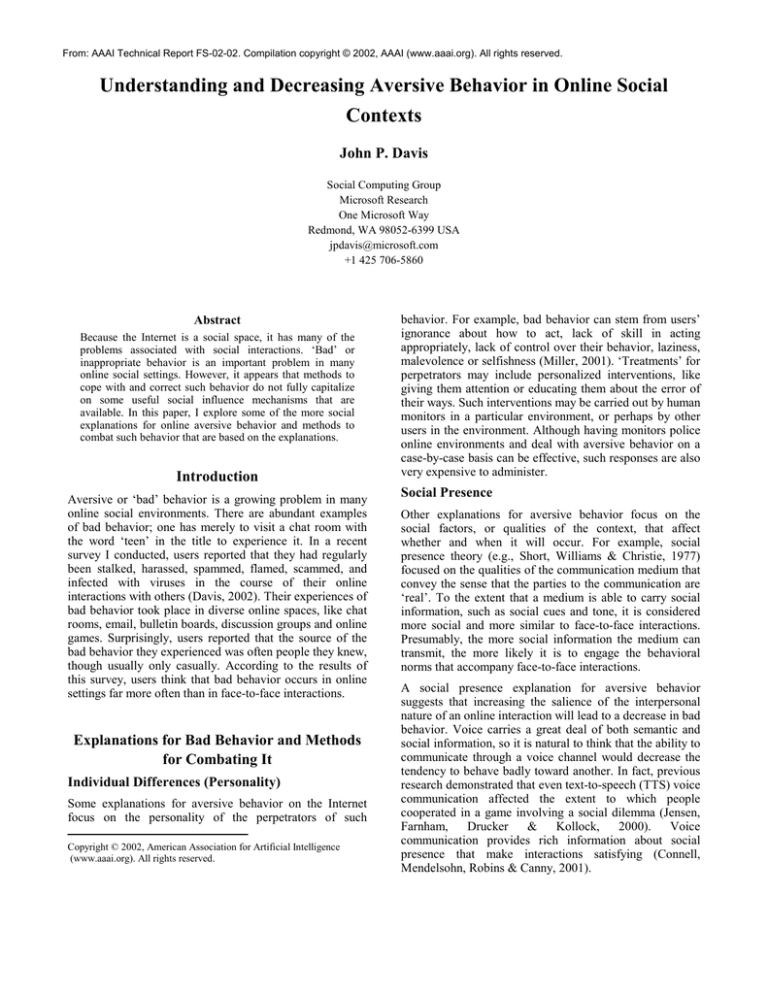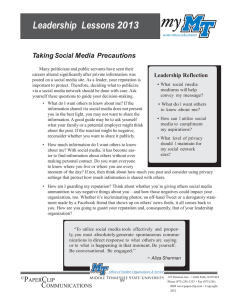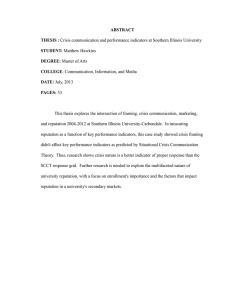
From: AAAI Technical Report FS-02-02. Compilation copyright © 2002, AAAI (www.aaai.org). All rights reserved.
Understanding and Decreasing Aversive Behavior in Online Social
Contexts
John P. Davis
Social Computing Group
Microsoft Research
One Microsoft Way
Redmond, WA 98052-6399 USA
jpdavis@microsoft.com
+1 425 706-5860
Abstract
Because the Internet is a social space, it has many of the
problems associated with social interactions. ‘Bad’ or
inappropriate behavior is an important problem in many
online social settings. However, it appears that methods to
cope with and correct such behavior do not fully capitalize
on some useful social influence mechanisms that are
available. In this paper, I explore some of the more social
explanations for online aversive behavior and methods to
combat such behavior that are based on the explanations.
Introduction
Aversive or ‘bad’ behavior is a growing problem in many
online social environments. There are abundant examples
of bad behavior; one has merely to visit a chat room with
the word ‘teen’ in the title to experience it. In a recent
survey I conducted, users reported that they had regularly
been stalked, harassed, spammed, flamed, scammed, and
infected with viruses in the course of their online
interactions with others (Davis, 2002). Their experiences of
bad behavior took place in diverse online spaces, like chat
rooms, email, bulletin boards, discussion groups and online
games. Surprisingly, users reported that the source of the
bad behavior they experienced was often people they knew,
though usually only casually. According to the results of
this survey, users think that bad behavior occurs in online
settings far more often than in face-to-face interactions.
Explanations for Bad Behavior and Methods
for Combating It
Individual Differences (Personality)
Some explanations for aversive behavior on the Internet
focus on the personality of the perpetrators of such
Copyright © 2002, American Association for Artificial Intelligence
(www.aaai.org). All rights reserved.
behavior. For example, bad behavior can stem from users’
ignorance about how to act, lack of skill in acting
appropriately, lack of control over their behavior, laziness,
malevolence or selfishness (Miller, 2001). ‘Treatments’ for
perpetrators may include personalized interventions, like
giving them attention or educating them about the error of
their ways. Such interventions may be carried out by human
monitors in a particular environment, or perhaps by other
users in the environment. Although having monitors police
online environments and deal with aversive behavior on a
case-by-case basis can be effective, such responses are also
very expensive to administer.
Social Presence
Other explanations for aversive behavior focus on the
social factors, or qualities of the context, that affect
whether and when it will occur. For example, social
presence theory (e.g., Short, Williams & Christie, 1977)
focused on the qualities of the communication medium that
convey the sense that the parties to the communication are
‘real’. To the extent that a medium is able to carry social
information, such as social cues and tone, it is considered
more social and more similar to face-to-face interactions.
Presumably, the more social information the medium can
transmit, the more likely it is to engage the behavioral
norms that accompany face-to-face interactions.
A social presence explanation for aversive behavior
suggests that increasing the salience of the interpersonal
nature of an online interaction will lead to a decrease in bad
behavior. Voice carries a great deal of both semantic and
social information, so it is natural to think that the ability to
communicate through a voice channel would decrease the
tendency to behave badly toward another. In fact, previous
research demonstrated that even text-to-speech (TTS) voice
communication affected the extent to which people
cooperated in a game involving a social dilemma (Jensen,
Farnham,
Drucker
&
Kollock,
2000).
Voice
communication provides rich information about social
presence that make interactions satisfying (Connell,
Mendelsohn, Robins & Canny, 2001).
Because the effects occurred even though the computer
generated voice contained the same semantic content as
simple textual communication, they led us to wonder
whether participants were inferring additional personality
characteristics about their gaming partners when they heard
a voice, causing them to behave differently toward them. If
so, perhaps access to another’s personalized information,
the type that may be inferred through a voice, would also
lead to increased social presence and decreased aversive
behavior. To explore this possibility, we conducted a
follow up study that varied mode of communication (i.e.,
TTS vs. text only) and the presence of personal profile
information. In this study, we found that voice
communication decreased aversive behavior, but having
access to personal profile information did not (Davis,
Farnham & Jensen, 2002). The presence of voice and
profile information did, however, cause the partners to rate
each other more positively before they played the game.
Individuating profile information seemingly has effects, but
the exact nature of those effects, and their relation to good
and bad behavior toward others, remain to be explored (see
Swinth, Farnham & Davis, 2002).
Deindividuation and Social Identity
Some have suggested that disinhibited behavior in
computer mediated communication (CMC) is caused by
deindividuation, which is the feeling that one has no
personal identity or uniqueness. Deindividuation may be
caused by several factors, including a reduction in the sense
accountability for one’s actions. CMC, compared to faceto-face interactions, may lead to differences in private selfawareness (a focus on internal motives, attitudes and goals)
and public self-awareness (a focus on the context or the
environment) (Matheson & Zanna, 1988). When people are
publicly self aware, they are concerned about being
evaluated by others and their status as a member of a group
or their social identity.
If deindividuation and its accountability component are
factors in online aversive behavior, methods that increase
users’ accountability for their behavior should also work to
decrease aversive behavior. As conceptualized in online
settings, a reputation is a sort of ‘behavioral record’ of
one’s actions, often within a particular context. For
example, e-commerce reputation systems (e.g., Ebay,
Amazon, Half.com) track the behavior of buyers and
sellers; sellers who fill orders quickly and accurately are
rated highly by the buyers who purchase from them.
Information-based sites may calculate a user’s reputation
by the number of informative posts she makes, or the
number and quality of her answers to others’ questions.
Users place a higher value on different types or pieces of
reputation information, depending on the online context in
which they expect to interact with the other person (Jensen,
Davis & Farnham, 2002).
Reputation systems work because a reputation is a valuable
social commodity, so if a person values her standing within
an online community, he should behave in a way that is
appropriate and builds a positive reputation. Good and bad
behavior is reflected in one’s reputation, and this
behavioral record holds one more accountable. An
important component of reputation systems is that they
provide users with feedback about their behavior from
others who have had interactions with them, feedback that
is often more direct than that found in typical face-to-face
interactions. Reputations may also work because they focus
users on the social norms associated with behavior in a
particular online context and engage a user’s public self
awareness.1
To test whether the ability to give and receive feedback can
have an impact on behavior in a social context, we recently
built and deployed a simple reputation system (Davis, Ma
& Farnham, 2002). In an experimental user study, we
randomly assigned users to one of twenty ‘social,’ emailbased distribution lists, each comprising ten people. All
groups discussed a range of topics chosen to induce interest
and interaction (e.g., “Should men wear jewelry?”). During
the two-week group interaction, half of the groups had
access to a reputation system through which they could
give other users anonymous feedback about their behavior
within the list, while the other half did not. We were
interested in whether the mere presence of a reputation
system would affect both users’ behavior within the groups
and their perceptions of their own and others’ behavior. In
addition, we wanted to explore how people used the system
itself. We found that both good and bad behavior occurred
in this context, and the reputation system itself was used
only moderately. In preliminary analyses, we have also
found that the groups with access to the reputation system
felt that there were fewer messages containing personal
attacks and were more satisfied with the interactions than
groups that did not have access to the system. It seems that
even simple social feedback can affect at least users’
perceptions of social interactions in online contexts.
One can imagine additional methods that capitalize on
activating behavior-relevant norms to decrease bad
behavior in an online context. For instance, asking users to
‘join’ a community to participate, whether the information
they are asked to provide about themselves is detailed or
not, may serve to make group membership salient and
decrease aversive behavior in the community. Perhaps
users could be asked to view a list of community members
or some other representation of membership to make the
norms for group behavior more salient. More thought is
needed to create and test additional ways to identify and
activate the critical norms in a particular context.
Additional Methods
Both personal profiles and reputations contain a great deal
of information about individuals in online environments,
and they can be useful for fostering positive interactions in
many contexts. However, they are less useful in curtailing
1
Note that personal profiles may also work to decrease
deindividuation and therefore decrease aversive behavior.
aversive behavior that occurs more immediately (i.e.,
synchronously). For example, when a user misbehaves in a
chat room, he is probably not concerned about the effects
of his behavior on his reputation in the chat room. Users
(and administrators) need ways to deal with such behavior
in a quick, effective, viable manner.
My current interests focus on identifying and testing
additional ways use group membership to decrease aversive
behavior in online settings. For example, ostracism or
‘shunning’ is a powerful social force for behavior change.
Current tools for ‘muting’ an offensive user in a chat room
allow people to filter his or her content; however, they
typically lack feedback to the offender about the action and
the reasons for the ostracism. Visible ostracism by a group,
particularly a valued group, can put considerable social
pressure on the perpetrator of the bad behavior and lead to
behavior change. One can imagine a user being given a
‘time out’ or put in a penalty box as a punishment for
behaving inappropriately. The key element is feedback to
the perpetrator: the fact that he was ostracized, the reason
for the ostracism and the way he can change his behavior to
return to the interaction.
References
Connell, J. B., Mendelsohn, G. A., Robins, R. W., and Canny, J.
(2001). Effect of communication medium on interpersonal
perceptions: Don’t hang up on the telephone yet! In Proceedings
of GROUP ’01 (Boulder, CO, USA, Sept. 30-Oct. 3), ACM
Press.
Davis, J. P. (2002). The experience of ‘bad’ behavior in online
social spaces: A survey of online users. Working paper.
Davis, J. P., Ma, M. and Farnham, S. D. (2002). Using a peer
rating system to improve online social behavior. Paper submitted
to CHI 2003.
Davis, J. P., Farnham, S. D. and Jensen, C. (2002). Decreasing
online ‘bad’ behavior. In Extended Abstracts of CHI '02
(Minneapolis, MN, April 2002), ACM Press.
Jensen, C., Davis, J. P. and Farnham, S. (2002). Finding others
online: Reputation systems for online social spaces. In
Proceedings of CHI '02 (Minneapolis, MN, April 2002), ACM
Press.
Taking Targets Into Account
Mechanisms for dealing with inappropriate behavior in
online settings should also take into account the reaction of
the target of the bad behavior. The obvious and immediate
goal for an intervention is stopping the perpetrator from
repeating the aversive behavior, but a secondary goal
should be to make the target of the behavior feel better
about the situation and stay in the environment. In other
words, it may be useful to allow users to ‘give voice’ to
their frustration and anger at perpetrators, whether or not
the response decreases the offending behavior. Users may
get little satisfaction from ‘muting’ another person in a chat
room, but they may feel better if they know the other user
has received feedback about the action. As I mentioned,
even when mechanisms for responding to bad behavior do
not actually decrease it, they may have a palliative effect on
the targets who are able to vent their frustrations, which
may have been the case in the ‘reputation system’ study
described earlier. This desirable outcome should not be
ignored.
Conclusion
Aversive behavior in online settings is a growing concern,
so it has become essential to identify and address its causes
and cures. It is also important to recognize the importance
of context—whether a behavior is considered aversive
depends upon the online environment in which it occurs.
Therefore, the fixes must fit the context. Social methods,
because they are largely user-driven, are bound to be more
effective long-term solutions than those that are laborious
to administer or rely too heavily on technology.
Jensen, C., Farnham, S., Drucker, S. and Kollock, P. (2000) The
effect of communication modality on cooperation in online
environments. In Proceedings of CHI ’00 (The Hague,
Netherlands, March 2000), ACM Press.
Matheson, K. and Zanna, M.P. (1990). Computer-mediated
communications: The focus is on me. Special Issue: Computing:
Social and policy issues, Social Science Computer Review, 8, p.
1-12.
Miller, R. S. (2001). Breaches of propriety. In Robin Kowalski
(Ed.) Behaving Badly: Aversive Behaviors in Interpersonal
Relationships. Washington, D.C.: American Psychological
Association.
Short, J., Williams, E. and Christy, B. (1976). The social
psychology of telecommunications. Chichester: Wiley.
Swinth, K., Farnham, S. D. and Davis, J. P. (2002). Sharing
personal information in online community profiles. Paper
submitted to CHI 2003.




